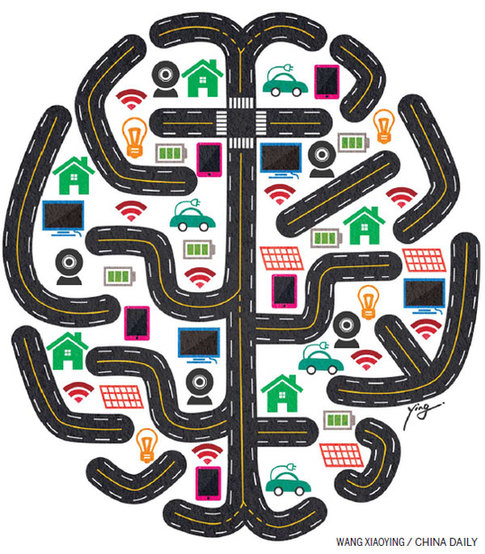'Smart' parking to ease congestion
High-tech lots offer real-time information on vacant spaces to increase efficiency
New technology could be about to provide a solution to Shanghai's chronic parking problems.
Fifteen "smart" car parks are being built using narrow-band internet of things technology, which those involved in the project say will make it easier for commuters and tourists to find empty spots, and ease traffic congestion.
By connecting to a smart car park's server via a mobile app, they say that drivers will be able to search for and reserve vacant spaces as well as pay for the time they are parked.

The lots, all in the Shanghai International Tourism and Resorts Zone, are a joint project by Huawei Technologies Co Ltd and state-owned telecom company China Unicom.
IoT refers to a network of vehicles or other objects containing software that allow them to exchange data, while narrow-band IoT is a low-power, wide-area technology that enables connections between IoT devices to be faster and operate on a wider range than bluetooth and Wi-Fi, while at the same time being cheaper.
Shen Zhou, an engineer for China Unicom's IoT business support center in Shanghai, says the smart technology will reduce the cost of building and managing the infrastructure and trunk gateways.
Zhong Bo, a senior developer of Ericsson in Northeast Asia, says the smart technology means telecom operators can play a bigger role in the IoT ecosystem and explore more growth areas by partnering with device manufacturers and industrial users.
The Swedish company has partnered with major international telecom firms to provide narrow-band IoT infrastructure and showcased the world's first standard connection application in July at the Mobile World Congress Asia in Shanghai.
"The technology can simplify the use of smart parking solutions and easily consolidate information for several parking lots on a single platform," Zhong says. "This can make the management and utilization of the parking area much more efficient."
However, he says it will still take time for modem manufacturers to produce mature, standardized technology.
Ulf Ewaldsson, a senior vice-president at Ericsson, adds that the advantage of narrow-band IoT is that by using existing infrastructure, such as networks and base stations, the technology will be usable by most telecom operators after a software update.
He says one implementation bottleneck is the research and development process of the chipsets that are embedded underneath the spaces in a smart car park. But with more countries and regions being attracted to the technology, he expects chip companies to accelerate to meet the demand.
ZTE Corp, a Chinese major telecom company, has actively invested in research on chips, terminals, systems and IoT platforms. The company recently exported its technology to Romania, to help the nation build its first smart car park in the western city of Timisoara.
Narrow-band IoT started drawing attention in March 2015, when Vodafone Group Plc and Huawei demonstrated a smart meter application at the Mobile World Congress in Barcelona.
Huawei, ZTE, China Mobile and China Unicom, along with other leading telecom technology providers and operators such as Ericsson, Etisalat, Intel, LG, Nokia, Qualcomm Inc, Telecom Italia, Telefonica and Vodafone, have also laid the foundations for a new industry forum aimed at accelerating ecosystems around narrow-band IoT, including the telecom industry and vertical market cooperation.
"The IoT is seen as the emerging industry with the most development potential due to the advanced technology achieved in mobile internet and big data," says Wang Xi, director of the Shanghai Institute of Micro-system and Information Technology. "Reliable business models in the IoT market had not appeared until the creation of narrow-band IoT."
In addition to smart parking, experts say the technology has many applications in a smart city, including in its environment, traffic, healthcare and public security.
"As the Made in China 2025 strategy is being pushed, and as domestic products replace imported chipsets, the integrated circuit sector will usher in a business worth more than 100 billion yuan ($15 billion; 13 billion euros), especially in fields such as narrow-band IoT and 5G," says Xu Tianshen, senior vice-president of global markets for Semiconductor Manufacturing International Corp in Shanghai.
Gartner Group, a technology research company, says it expects 6.4 billion yuan worth of connected devices to be in use next year, up 30 percent from this year, with the figure reaching 20.8 billion yuan by 2020. Spending on IoT services is also forecast to grow 22 percent to 235 billion yuan this year.
Data from the China Center for Information Industry Development, a think tank attached to the Ministry of Industry and Information Technology, show the nation's IoT market increased at a rate 30.5 percent between 2010 and 2014, from 195.8 billion yuan to 567.9 billion yuan.
The organization says it expects the global IoT market will see 61 percent growth over the next five years.
liuzheng@chinadaily.com.cn


















